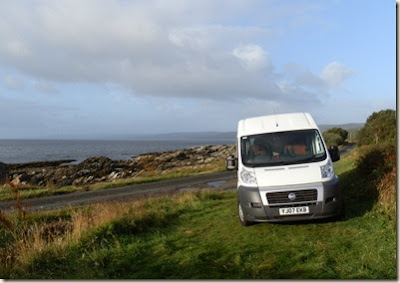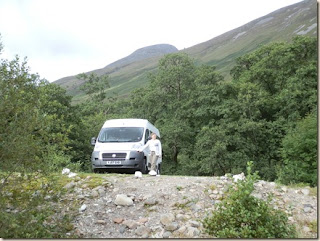Boots nicely muddied we leave Glencoe and take
Duckie to Glen Nevis where we rub shoulders with some ‘proper’ motor caravanners on another highly organised site. It being quite late in the season we can park anywhere we fancy so position ourselves so that Carn Dearg’s quartzite summit winks at us through the trees just beneath the shoulder of the Ben Nevis massif. It appears that our new battery, which provides power for lights and also enables us to pump water inside the van, is not getting charged from the engine as it should but such a minor inconvenience does not prevent us from hitting the road again the next day, beating into a westerly blow and driving rain as we press on westwards to Arisaig. This is a place Kate remembers from her childhood holidays – this trip is turning out to be full of reminiscences.
Although we are fully equipped and happy to camp ‘wild’ we are finding that often this is discouraged where there are already camp sites to choose from so here on the Keppoch peninsula we locate a site that looks good, with a view across the sea to Eigg, Rum and Skye ready to greet us when the rain blows itself away.
The campsite owners have bravely placed a notice here stating that nightlife is likely to be absent, unless it is of the small flying and biting variety, but we find this encouraging rather than discouraging and soon the gentle rocking of the van in the wind lulls us to sleep.
Dawn brings with it a change in the weather and peering out at the view this confirms our decision to stop here. Pink-tinted clouds hover over a sea which is loaded with islands right across the horizon, a real treat for our eyes. Having had some experience of the changeability of Scotland’s weather, of course, we know better than to expect it to remain fine for long so after dawdling around on the beach for half the day we drive off again, making it as far south as the Ardnamurchan peninsula before the clouds once again roll in.

A long, ridiculously narrow road brings us to Sanna where the mist hides the few small islands which lie between us and America, but we know they are there just the same. The beaches here are bright and clean, made not from sand but from coral and tiny pieces of shell which gives them a special quality, one that is favoured by a taller variety of limpet and cockles with shells that come in rainbow colours. Despite the damp the air is quite warm beside the sea but it is getting late so we retrace our track along the single-track road to find a spot where nobody is likely to disturb us, a place where even a large white van is lost amongst the heather and coarse grass. The sense of remoteness here on Ardnamurchan has a new order of magnitude. The by-road past Kilchoan is like a thread winding onwards over the hills, passing through a land shaped by nature where man’s influence is barely a scratch. Rounded boulders stick out of the heather-covered ground, formed volcanically then scraped smooth by glacial ice and still bare of soil after thousands of years. Either time moves more slowly here or else the land just resists change, of its own accord.
Driving slowly on, still on roads barely wider than our wheels, we reach Loch Sunart and follow its northern shore to a village called Strontian, a name made famous by the element Strontium, discovered in the now disused lead mines which lie hidden in the mountains close by. If ever there was a village which matches Carradale in terms of size, (in-)accessibility, general surroundings and sense of community, then this is it.

We find houses built to exactly the same pattern as our own, from the same set of bricks almost, and the midges even looked at us the same way as they do back home. Just like in Carradale, walk a short distance up the hillside and you are treated to a terrific view, in this case westward along the longest sea loch in the Highlands. Our camp site owner is an enthusiastic entrepreneur who was drawn to the Highlands in a similar way to us and is making a great life for himself and his family. Even in these remote places many of our overnight camping sites have been full of tourists, from England, Europe and the USA, so clearly there is a living here for anyone who has the imagination and enthusiasm to take advantage of the opportunities on offer.
The world of caravanning is slowly opening up before us as we travel about in our new home although we sense that we might not quite be doing things as others are. We don’t have a table and chair set to erect outside the moment we arrive at a camp site, somewhere to sit around eating supper and shivering whilst the midges feed. We sense others looking down their noses at our lightly equipped style and our one night stopovers but we don’t care. Before leaving Strontian, though, we have to take advantage of the fine morning to visit the ancient Ariundle oak woods. Amongst these trees are moss-covered stones, some of them once used in building a croft or an ancient fortified structure, which lie sleeping beneath the oaks and birches. The area is being actively preserved from intrusion by sheep or deer to preserve it as a uniquely valuable habitat and we would like to linger longer but need to head back to Oban to try to sort out the van’s electrical problems. From Strontian the quickest route is to use the ferry at Corran, a place where Loch Linnhe narrows, forcing the tide to rush through a small gap beneath the mountains of Ardgour. The crossing turns out to be very easy - we just drive up and bounce on board - and the meagre cost surprises us. We were expecting to pay more for our large vehicle but we grin to ourselves and keep quiet about it, especially not bragging to the gang of bikers who are crossing with us.

These are serious tourists most of whom who have travelled up from England to a meet at Kilchoan on Ardnamurchan and we feel sorry for them later when the rain begins to fall.
At Barcaldine we pull into the former walled garden of a once great estate, now converted to a grand camping site, and have barely parked before the heavens open. This site has such a high sense of order about it that it terrifies us. The toilet/shower block closes for cleaning on the dot of 12.30 each day. It is beyond spotless. The grass grows only where it knows it must and there are gates which close at 11pm to prevent foolishly disorganised campers from arriving or departing. Despite these (in our view) failings there is a warm welcome from the managers who clearly run their lives around the camping season.
Our little break over, all that remains is to trundle back home. The electrical problem in the van persists and will need further attention by someone with greater skills than I but everything else works well and promises to deliver us a whole new world of adventures.














